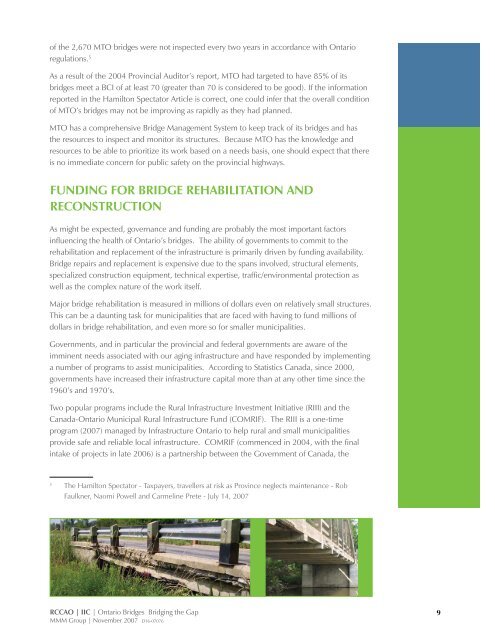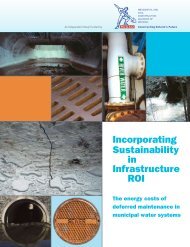objective was not necessarily to prepare a statistical analysis of the data, but to see to what extent bridge datawas available and how it was being used. The responses to this request provided a valuable high level insightinto the state of Ontario’s bridge infrastructure.In addition to the questionnaire, discussions were held with the MTO, Region of York, City of Toronto, Town ofOakville, County of Simcoe and Lennox & Addington County. OGRA and engineering firms that conduct bridgeinspections and condition surveys were also consulted.Out of the over 440 questionnaires that were mailed out, information was received or made available from150 municipalities (approximately 1 out of 3), including information from 89 municipalities associated withthe Eastern Ontario Warden’s Caucus (EOWC). The data collected encompassed approximately 4,000 of the12,000 municipal bridges (1 out of 3) and 2,800 of the 5,400 municipal culverts (1 out of 2). A summary of theresponse data is provided in Appendix B.As expected, the responses did not provide information in a form that could be used in a meaningful statisticalanalysis. Responses varied from very detailed structural element needs information to other data with missingand incomplete answers. This significant variation in responses highlights the need to have a consistentapproach to data collection, a common understanding of structural needs, and a thorough and consistentreporting process. Although it would be desirable to obtain more standardized statistical reporting informationfrom COMRIF reporting requirements and the Municipal DataWorks program (if it were available), we are notconfident that this effort would produce results that would be useful for producing anything beyond a broad,aggregate statement.Knowing the limitations of the collected data, the data were filtered to remove possible discrepancies. Followingare general findings from the analysis undertaken:• On average, 14% of a municipality’s bridges and culverts fall into the Now needs category, and 26% fall intothe 1-5 year needs category.• The average cost of repairs for each municipal bridge/culvert need is about $325,000 in the Now categoryand $300,000 in the 1-5 year category.• Extrapolating these average costs to include all municipal bridges and culverts in the province results in anestimated cost of just under $1 billion for Now needs bridges, and at least $2 billion for both the Now and1-5 year needs combined.• No further conclusions can be derived from analysing these data, except to confirm that there is animmediate Now need which must be addressed.PROVINCIAL BRIDGE INVENTORY INFORMATIONThe MTO owns, operates and maintains approximately 2,800 bridges and 1,900 culverts larger than 3m spanin Ontario. A meeting was arranged with MTO to discuss the status of bridge rehabilitation in Ontario and arequest was made for a copy of the provincial data base. Although MTO may provide the applicable standardsand guidance for the bridge inspection program, MTO confirms that they do not manage or keep any records ofmunicipal structures. MTO only manages and keeps records on the provincial highway system.MTO provided an electronic file copy of their bridges across the province. However, the financial needsinformation was not included in the electronic file.Based on information received from MTO under the Freedom of Information Act (FOI), the Hamilton Spectatoridentified some troubling statistics on MTO’s bridges. In 2006, only $36 million of the $210 million scheduledfor bridge repair on provincial highways in the Golden Horseshoe was actually undertaken; and 187 (7%)8
of the 2,670 MTO bridges were not inspected every two years in accordance with Ontarioregulations. 5As a result of the 2004 Provincial Auditor’s report, MTO had targeted to have 85% of itsbridges meet a BCI of at least 70 (greater than 70 is considered to be good). If the informationreported in the Hamilton Spectator Article is correct, one could infer that the overall conditionof MTO’s bridges may not be improving as rapidly as they had planned.MTO has a comprehensive Bridge Management System to keep track of its bridges and hasthe resources to inspect and monitor its structures. Because MTO has the knowledge andresources to be able to prioritize its work based on a needs basis, one should expect that thereis no immediate concern for public safety on the provincial highways.FUNDING FOR BRIDGE REHABILITATION ANDRECONSTRUCTIONAs might be expected, governance and funding are probably the most important factorsinfluencing the health of Ontario’s bridges. The ability of governments to commit to therehabilitation and replacement of the infrastructure is primarily driven by funding availability.Bridge repairs and replacement is expensive due to the spans involved, structural elements,specialized construction equipment, technical expertise, traffic/environmental protection aswell as the complex nature of the work itself.Major bridge rehabilitation is measured in millions of dollars even on relatively small structures.This can be a daunting task for municipalities that are faced with having to fund millions ofdollars in bridge rehabilitation, and even more so for smaller municipalities.Governments, and in particular the provincial and federal governments are aware of theimminent needs associated with our aging infrastructure and have responded by implementinga number of programs to assist municipalities. According to Statistics Canada, since 2000,governments have increased their infrastructure capital more than at any other time since the1960’s and 1970’s.Two popular programs include the Rural Infrastructure Investment Initiative (RIII) and theCanada-Ontario Municipal Rural Infrastructure Fund (COMRIF). The RIII is a one-timeprogram (2007) managed by Infrastructure Ontario to help rural and small municipalitiesprovide safe and reliable local infrastructure. COMRIF (commenced in 2004, with the finalintake of projects in late 2006) is a partnership between the Government of Canada, the5The Hamilton Spectator - Taxpayers, travellers at risk as Province neglects maintenance - RobFaulkner, Naomi Powell and Carmeline Prete - July 14, 2007RCCAO | IIC | Ontario Bridges Bridging the GapMMM Group | November 2007 D16-070769



